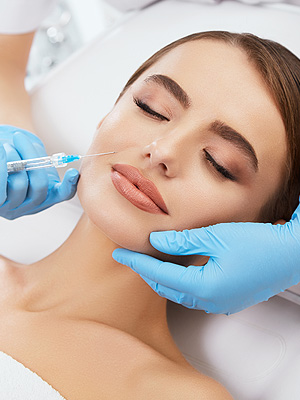Drooping Eyelids
Drooping Upper Eyelid (Ptosis)
Ptosis, or drooping of the upper eyelid, can block the pupil and obstruct the upper field of vision – making it especially difficult to read or drive and making the individual appear sleepy. Many people with severe symptoms lift their eyelids with their fingers in order to see.
Drooping Upper Eyelid (Dermatochalasis)
Dermatochalasis or excess skin of the upper eyelid is also referred to as “hooding”. The eyelid skin is the thinnest on the body and over a lifetime it thins and stretches.
Additionally, your eyebrow can droop or your forehead can sag causing excess skin to be pushed down onto the upper eyelids. This condition causes patients to look tired, experience a heavy or fatigue sensation of their eyelids, and in some cases note limitations of their peripheral vision.
Drooping Lower Eyelid (Ectropion)
When the lower eyelid turns outward (Ectropion) the eye is exposed. This condition can be extremely uncomfortable, and the patient can experience dryness, burning, and/or excessive tearing. In rare cases, these conditions can cause serious eye problems.
Drooping Lower Eyelid (Entropion)
When the lower eyelid turns inward (Entropion) the lashes rub against the eye. This condition can be extremely uncomfortable, and the patient can experience dryness, burning, and/or excessive tearing. In rare cases, these conditions can cause serious eye problems.
This condition, which can affect one eye or both eyes, can be present at birth or can be caused by aging, trauma, changes in the muscles that lift the eyelids, or neurologic diseases.
Ptosis may also result from long-term contact lens use or ocular surgery. Children with ptosis may develop amblyopia (“lazy eye”), which can cause a developmental delay.
Treatment for Ptosis
Depending on its cause and severity, ptosis can be corrected by a variety of surgical procedures to lift the eyelid margin and lashes improving one’s visual field. These surgeries are usually performed on an outpatient basis in an ambulatory surgery center – with minimal pain and relatively quick healing.
In cases where the eyelid margin covers the pupil insurance typically covers the repair procedure. Our specialists will thoroughly diagnose your condition and recommend a treatment plan that works best for you and your lifestyle.
The Advantage
When you choose to treat your ptosis symptoms, you’ll benefit from the expertise of Dr. Richard Roth, one of the finest surgeons in the Northeastern Pennsylvania area. Dr. Roth is a dual board-certified oculoplastic surgeon (cosmetic, corrective, and reconstructive surgery of the eye).
Advanced specialized training in both ophthalmology and plastic reconstructive surgery has enabled him to combine his keen artistic eye with the meticulous, detailed microsurgery techniques of ophthalmology. This combination will provide you with the exceptional results you desire.
Call (570) 718-4188 or click here to Schedule Appointment or for more information.



